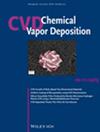Atomic Layer Deposition of Groups 4 and 5 Transition Metal Oxide Thin Films: Focus on Heteroleptic Precursors†
Abstract
The atomic layer deposition (ALD) process, an alternative to CVD, is universally appreciated for its unique advantages such as excellent repeatability, conformity, and thickness control at the atomic level. ALD precursor chemistry has mainly been based on homoleptic compounds such as, but not limited to, metal halides, alkylamides, and alkoxides, however these precursors have drawbacks such as possible halide contamination and low thermal stabilities in the case of the alkylamides and alkoxides. Consequently, heteroleptic precursors have been investigated as alternatives to the existing homoleptic counterparts, leading to the development of several advantageous processes. Nevertheless, there is no thematic review dedicated to the heteroleptic precursors and their properties, and it seems that no coherent strategy has been adopted for the development of heteroleptic precursors. This review gives a brief description of ALD and presents studies on the deposition of thin films of groups 4 and 5 metal oxides using ALD. A description of the general ALD properties of homoleptic precursors, in addition to a review on the thermal ALD of groups 4 and 5 metal oxides from heteroleptic precursors, is provided. Trends in the properties of heteroleptic ALD precursors, based on the literature review and recent experimental data, are discussed.

 求助内容:
求助内容: 应助结果提醒方式:
应助结果提醒方式:


